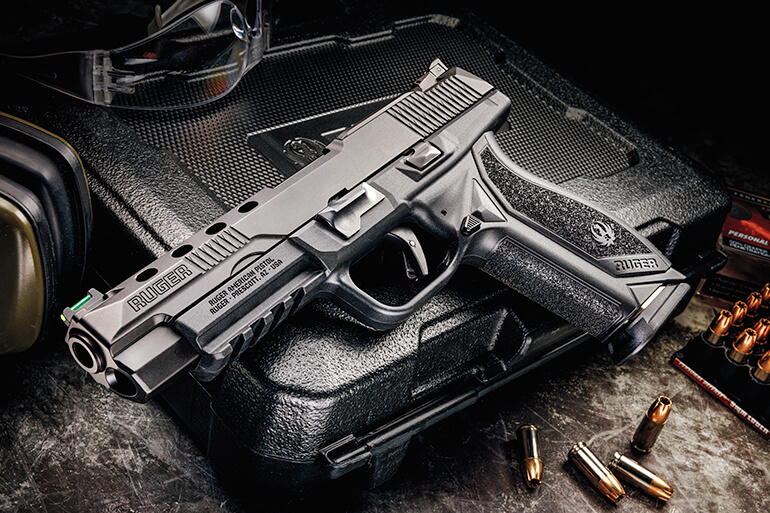
February 03, 2021By Guns & Ammo Staff
Ruger’s new American Pistol Competition is a race-ready 9mm that’s surging ahead in the game. Ruger has blended components of the standard American Pistol with special-purpose features intended to appeal to IDPA, IPSC and USPSA shooters.
The Competition model is still a striker-fired, polymer-frame semiautomatic. All Ruger American Pistols feature a pre-tensioned striker with a heavy-duty spring resulting in consistent, reliable primer strikes. The Competition model tested by Guns & Ammo produced a trigger pull of 6½ pounds. The trigger also has a short reset, about .2 inch, which facilitates faster follow-up shots, important when earning a spot on the podium can come down to tenths of a second. Audible and tactile cues signal when the trigger is reset and ready to fire again.
Like the standard American Pistol, Ruger’s Competition model comes with a one-piece machined stainless-steel chassis with integral frame rails and fire control housing. The chassis, barrel and slide all come with a durable black nitride finish that resists weather, wear and corrosion.
Ruger American Pistols are especially notable for their modular grips. The Competition comes with three grip modules: small, medium, and large. Installation and removal are slightly different than with most competing polymer pistols. Instead of a pin that is driven crossways or vertically through the base of the grip, Ruger uses a cam system. There’s a cutout in the rear of the grip module with the cam inside. Using the provided Torx wrench, turn the cam a quarter-turn counterclockwise to unlock, then pull the module down and back to remove. Replace it in the reverse order, but be careful not to overtighten the cam. Functional stippling completes the grip, covering the frontstrap, as well as the sides and back of the grip module.
The American Pistol Competition sent to G&A for testing was a “Pro” sub-model, which is how Ruger refers to handguns without manual safeties. However, the Competition’s two passive safeties include an internal automatic sear block system and an integrated trigger safety. There is also a viewing port to check for a loaded chamber, and takedown does not require tools or a trigger pull.
In terms of controls, southpaws will appreciate that Ruger designed the American Pistol Competition to be ambidextrous. That means left-handed shooters won’t have to spend time disassembling the gun to swap the slide stop or magazine release; bilateral controls are standard. The slide stop, which is pyramidal in cross section, is large enough that it can easily be found and manipulated. The small, triangular mag release button is located just aft of the trigger, and molded fencing on the frame helps to protect against accidental mag drops. Takedown is a breeze, and the large lever rotates to release the slide, spring and barrel from the frame.
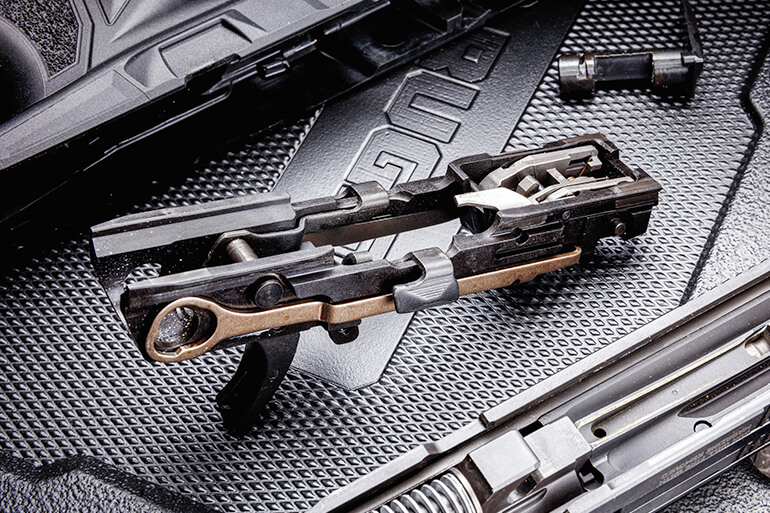
Other features shared with the standard Ruger American pistol include an over travel stop moulded inside the trigger guard, an accessory rail on the frame, 17-round, nickel- and Teflon-plated, double-stack magazines with a chamber that’s +P rated.
Standout Similar as they are, the two guns are not identical. The Competition version comes with a removable sight plate with pre-drilled mounting holes that accommodate a number of modern red-dot sights, including those from Docter, Sightmark and Vortex. Screws are not included, however. You’ll need #6-48 mounting screws to attach a red dot. The optics-ready design is convenient, but the iron sights on the Competition are also well-designed and perfectly suited for a match gun. An adjustable, serrated rear sight is paired with a fiber-optic front, both of which are dovetailed into the slide. Adjusting point of impact on the rear sight is simple and requires nothing more than a small flathead screwdriver. To change the impact on target, the screw on the top of the sight controls elevation while the screw on the right side adjusts windage.
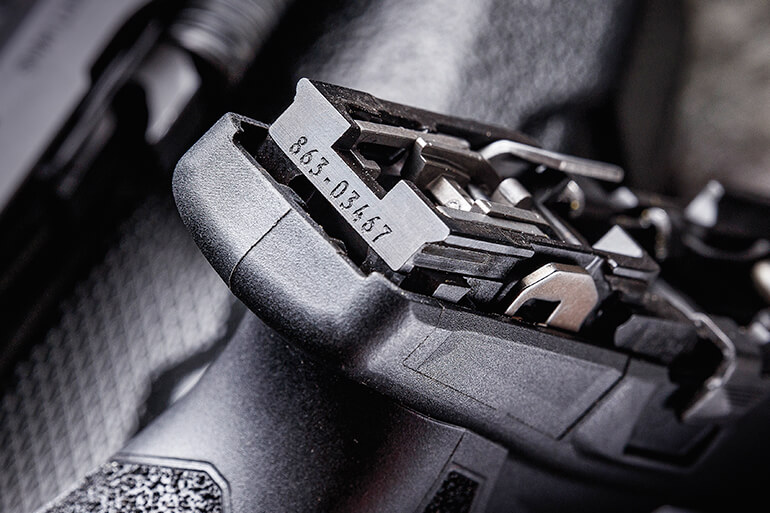
Other distinctions include the lightening cuts, or small ports, on either side of the slide. The Competition model also comes with both front and rear serrations, unlike the standard model which only sports rear serrations.
Ruger’s striker-fired Competition pistol sends rounds downrange through a 5-inch barrel, compared to the 4.2-inch tube of the standard. The additional length gives the Competition a heavier feel and extends the sight radius, a benefit when shooting with irons. Also interesting, the Competition’s barrel features a 1:16-inch twist to better support the lighter bullets popular among competitive shooters. The standard American pistol, by contrast, has a faster 1:10 twist rate that’s ideal for heavier defensive-type bullets such as 147-grainers.
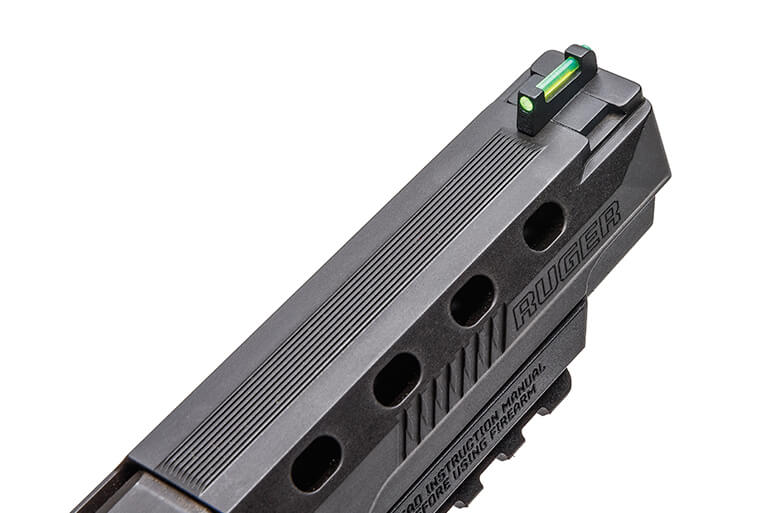
With its added slide length, the Competition weighs 34 ounces empty, about 4 ounces more than the standard model. When attaching a red-dot sight and inserting a full magazine, the weight was 2 pounds, 2.1 ounces, which is on par with an iron-sighted, steel-frame Model 1911. The added weight serves the competition shooter by absorbing felt recoil and reducing muzzle flip. The nose-heavy approach is a bonus for competitive shooters because the weight smooths transitions from target to target in the same way a professional sporting clays shooter uses 32-inch shotgun barrels to even out the gun’s swing.
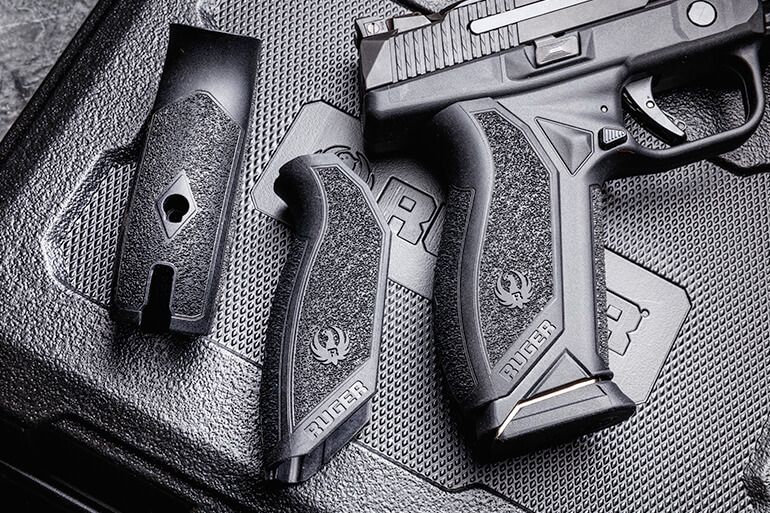
Unexpectedly, both the standard American Pistol and the Competition model share the same MSRP of $579. When compared to similar approaches to a 9mm, striker-fired and red-dot-ready handgun used in the same competitions, the Glock G34 Gen5 in 9mm with MOS carries an MSRP of $851. Smith & Wesson’s M&P9 M2.0 Performance Center CORE sells for $721. All three striker-fired pistols come with 17-round magazines, and +2 mag extensions are available at kearms.com for $25. All have barrels that measure between 5 and 5.31 inches. Though all three guns are somewhat similar, the Ruger weighed 10 ounces more than either the Glock or the Smith & Wesson. In terms of price, the Ruger American Pistol Competition is the runaway winner.
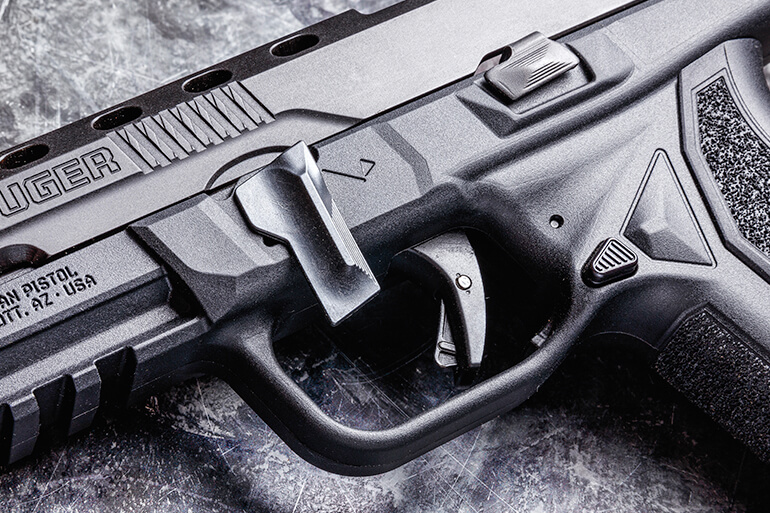
At The Range
The Ruger Competition model is a pistol that begs to be shot quickly. The grip design and deep undercut on the rear of the grip encourages a high, aggressive, thumbs-forward hand position that maximizes control. It’s more sharply angled than other competition pistols, including the Glock, but the profiling makes sense on this gun since most competitive shooters utilize a more aggressive grip than the average person.
The ported slide runs smoothly and quickly when firing target loads, and the recoil pulse is extremely manageable. There were no failures to feed, extract or eject with any of the loads tested. The large side-mounted extractor bit firmly on the case and the nickel-Teflon plated magazines were easy to use and lock into place.
On two occasions, with two different loads, the slide failed to lock back after the last round was fired. And, by inserting a full magazine with force, a locked-back slide can be released to return forward and chamber a round. Some people may prefer a more solid slide lock, but for some shooters and competitors, Ruger’s designers will have hit a sweet spot.
The Competition proved to be quite accurate. Tested with a red dot mounted, G&A’s pistol printed five-shot groups from 25 yards as small as 1.35 inches using a Caldwell rest. With ammo it likes, and a steady rest, five shots under 2 inches were not uncommon. We also tested a variety of ammo weights from 100 grains to 147. Despite its slow twist rate, the Ruger still shot the heaviest loads well. Without the red dot, our average groups opened up to between 2 and 3 inches, as expected.
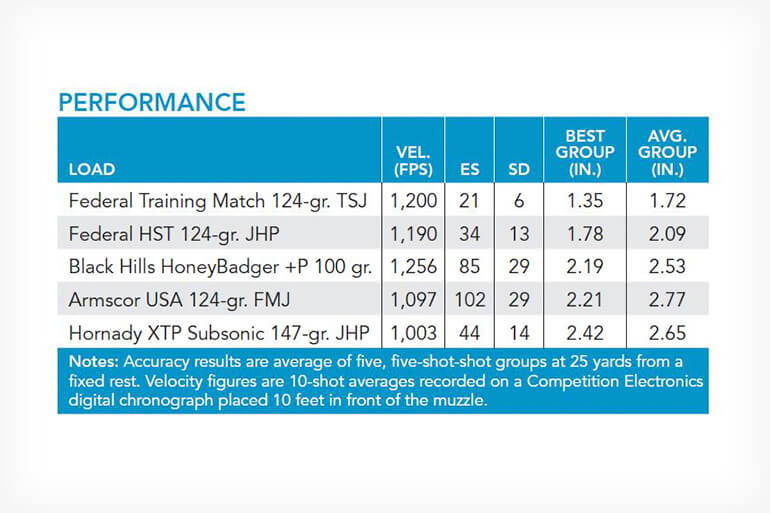
While the Ruger American Pistol Competition accepts a number of excellent reflex sights, some existing red dots do not fit without machine work. That means you would have to find and purchase a mounting plate if your sight isn’t on the list. During this evaluation, we also noted fewer holsters available for this gun than the more established competition pistols such as those from Glock, SIG Sauer and Smith & Wesson.
Overall, Ruger should have a winner with the American Pistol Competition — and not just among competition shooters. This is a solid pistol all around. What’s more, the price falls below its major competitors, which has been a winning strategy for Ruger all along.

Ruger American Pistol Competition Specs
Type: Striker fired, recoil operated, semiautomatic
Cartridge: 9mm
Capacity: 17+1 rds.
Barrel: 5 in., stainless steel
Overall Length: 8.31 in.
Width: 1.05 in.
Height: 5.60 in.
Weight: 2 lbs., 2.1 oz.
Grip: Interchangable, non-slip modules
Finish: Black nitride (stainless steel); nickel Teflon (steel)
Trigger: 6 lbs., 8 oz. (tested)
Sights: Fiber optic (front); adjustable target (rear); reflex optic ready
Safety: Internal sear block, trigger safety lever
MSRP: $579
Manufacturer: Sturm, Ruger & Co., 336-949-5200, ruger.com



